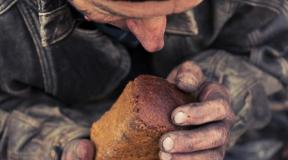Tobrex eye drops. Tobrex drops: instructions for use of Tobrex from a cold
Description
Transparent solution from colorless to light yellow or brown.
Composition
Each ml of the drug contains:
active substance: tobramycin - 3.0 mg;
Excipients: boric acid, sodium sulfate anhydrous, sodium chloride, tyloxapol, benzalkonium chloride, sodium hydroxide and / or sulfuric acid (to adjust the pH), purified water.
Excipients, the presence of which must be taken into account in the composition medicinal product: benzalkonium chloride - 0.1 mg.
Pharmacotherapeutic group
Means used in ophthalmology; antibiotics.
CodeATX: S01AA12.
pharmachologic effect
Pharmacodynamics
Mechanism of action:
Tobramycin is an active, fast-acting, bactericidal aminoglycoside antibiotic wide range actions. The main effect on bacterial cells is through inhibition of the assembly and synthesis of the polypeptide on the ribosome.
Mechanism of resistance:
Resistance to tobramycin develops due to various mechanisms, including: 1) changes in the ribosome subunit inside the bacterial cell; 2) violation of the transport of tobramycin into the cell; 3) inactivation of tobramycin by adenylation, phosphorylation and acetylation by enzymes. Bacterial chromosomes or plasmids can carry genetic information about the formation of inactivating enzymes. Cross-resistance with other aminoglycosides is possible.
Boundary values:
Below are cut-off values and in-vitro spectrum for systemic use. These cut-off values may not be applicable for topical ophthalmic use, since in this case higher concentrations are observed and the physical / chemical conditions at the site of administration may affect the activity of the drug. According to EUCAST, the following cut-off values are set for tobramycin:
Enterobacteriaceae S≤2 mg / l, R> 4 mg / l; Pseudomonas spp. S≤4 mg / l, R> 4 mg / l; Acinetobacterspp. S≤4 mg / l, R> 4 mg / l; Staphylococcus spp. S≤1 mg / l, R> 1 mg / l; regardless of the type S≤2 mg / l, R> 4 mg / l.
Clinical efficacy against specific pathogens:
The information below is a rough guide to the possible susceptibility of microorganisms to the tobramycin contained in TOBREX. The following are strains of microorganisms that are found in external eye infections, such as conjunctivitis.
The frequency of acquired resistance of some strains may vary by location and time, so it is advisable to have local knowledge of microbial resistance. In particular, expert advice is necessary in cases of treatment of severe infections in an area where the resistance of microorganisms is such that the effectiveness of the use of tobramycin, at least for some types of infections, is questionable.
Susceptible strains:
Bacillusmegaterium. Bacilluspumilus, Corynebacterium accolens, Corynebacterium bovis, Corynebacterium macginleyi, Corynebacterium pseudodiphtheriticum, Kocuria kristinae, Staphylococcusaureus(methicillin sensitive - MSSA), Staphylococcusepidermidis (coagulase positiveand negative)Staphylococcushaemolyticus(methicillin sensitive - MSSH), Streptococci(including some species from group Abeta hemolytic, some typesnon-hemolyticand someStreptococcus pneumonia).
Acinetobacter calcoaceticus, Enterobacter aerogenes, Escherichia coli,Acinetobacter junii, Acinetobacter ursingii, Citrobacter koseri, H.aegyptius, Haemophilus influenzae, Klebsiella oxytoca, Klebsiella pneumoniae, Morganella morganii, Moraxella catarrhalis, Moraxella oslonensis, Moraxella lacunata, some typesNeisseria, Proteus mirabilis,most strainsProteusvulgaris. Pseudomonasaeruginosa, Serratia liquifaciens.
Strains that can acquire resistance:
Acinetobacter baumanii, Bacillus cereus, Bacillusthuringiensis, Kocuria rhizophila, Staphylococcushaemolyticus (methicillin resistant - MRSH), Staphylococcus(other coagulase-negative species), Serratia marcescens.
Microorganisms with their own resistance:
- aerobic gram-positive microorganisms: Enterococci faecalis, Staphylococcusaureus (methicillin resistant - MRSA), Streptococcusmitis, Streptococcus pneumonia, Streptococcuspyogenes, Streptococcussanguis;
- aerobic gram-negative microorganisms: Haemophilus influenzae, Stenotrophomonas maltophilia, Chryseobacterium indologenes, Burkholderia cepacia;
- anaerobic microorganisms: Propionibacteriumacnes.
Bacterial susceptibility studies show that in some cases, microorganisms resistant to gentamicin remain susceptible to tobramycin.
Pharmacokinetics / pharmacodynamics relationship:
A specific pharmacokinetics / pharmacodynamics model has not been established for TOBREX. Published in vitro and in vivo studies show that tobramycin has a prolonged post-antibiotic effect, effectively inhibiting bacterial growth despite low serum concentrations. In studies on systemic use, higher maximum concentrations have been reported with a single dose. daily use compared with multiple daily dosing regimen. Meanwhile, the totality of available data indicates that a single daily systemic use is equivalent in effectiveness to a multiple daily dosing regimen. Tobramycin has a concentration-dependent bactericidal effect at levels above the minimum inhibitory (MIC) and minimum bactericidal (MBC) concentrations.
Clinical trial data:
The cumulative safety data from clinical trials can be found in the Adverse Reactions section.
Elderly patients:
There were no clinical differences in safety or efficacy between the elderly and other adult patients.
Pediatric patients:
AT 10 clinical research who used eye drops or ophthalmic ointment containing tobramycin to treat bacterial conjunctivitis, blepharitis or blepharoconjunctivitis, more than 600 patients participated childhood... The patients' age ranged from 1 to 18 years. Overall, the safety profile for pediatric patients did not differ from that for adult patients. For children under 1 year of age, there are no dosage recommendations due to the lack of relevant data.
Pharmacokinetics
Absorption:
Tobramycin penetrates poorly through the cornea and conjunctiva in rabbits and undergoes minimal absorption by the tissues of the eye after topical application.
In addition, systemic absorption of tobramycin with topical ophthalmic use of drugs containing tobramycin in a concentration close to that of TOBREX (0.3%) is clinically insignificant.
Thanks to high concentration tobramycin in the TOBREX preparation, its concentration is much higher at the site of infection (eye surface) than the MICs of most resistant strains (MICs> 64 μg / ml; the concentration of tobramycin in the human eye a minute after administration of one dose of TOBREX is 848 ± 674 μg / ml).
Concentration of tobramycin in tears healthy person exceeds MIC90 (16 μg / ml, as described for ophthalmic strains) for at least 44 minutes after using TOBREX.
Distribution:
The volume of distribution in humans is 0.26 l / kg. The binding of tobramycin to human plasma proteins remains low and is less than 10%.
Biotransformation:
Tobramycin is excreted mainly unchanged in the urine.
Derivation:
Tobramycin is rapidly and actively excreted by glomerular filtration in the urine in a predominantly unchanged form. The plasma half-life is approximately two hours. Systemic clearance in adult patients with normal renal function varies from 0.05 to 0.1 L / h / kg and decreases with decreasing renal function.
Linearity / non-linearity:
Ophthalmic or systemic absorption with increasing dose concentration with topical ophthalmic application has not been studied. Therefore, a linear relationship between exposure and dose cannot be established.
Patients with impaired liver and kidney function:
There have been no studies evaluating the use of TOBREX in this type of patient. However, due to the low systemic absorption of tobramycin in topical application dose adjustment is not required.
Pediatric patients:
TOBREX can be used in children aged 1 year and older in the same dosage as in adult patients. There are limited data on the use of TOBREX in children under 1 year of age.
Indications for use
TOBREX is indicated for the treatment of external infections of the eyes and their appendages in adults and children aged 1 year and older, which are caused by bacteria sensitive to tobramycin, including bacteria that are not susceptible to most other antibiotics, especially Pseudomonas aeruginosa.
As with other antibiotics, antimicrobial therapy should be monitored.
Contraindications
Hypersensitivity to the active substance or to any excipient, a list of which is given in the "Composition" section.
Hypersensitivity to aminoglycosides.
Method of administration and dosage
Dosage;
- at diseases of mild severity: 1 or 2 drops in the eye (s) every 4 hours;
– with more severe infections: 2 drops per eye s ( a) every hour before improvement is achieved, after which, before stopping treatment, the dosage should be reduced.
The duration of treatment depends on the origin of the infection and can range from a few days to several weeks.
Application in pediatric patients:
TOBREX eye drops can be used in children from 1 year old in the same dosage as in adults. The currently available application data are given in the Pharmacodynamics section. Safety and effectiveness of use of this drug in children under the age of 1 year is not established, data are not available.
Use in elderly patients:
There are no differences in clinical data on the efficacy and safety of use in adults and elderly patients.
Use in patients with concomitant liver and kidney diseases:
The efficacy and safety of TOBREX in patients with concomitant liver and kidney diseases have not been established.
Mode of application:
For topical use in ophthalmology.
After opening the vial, before using the drug, remove the tear-off ring, which provides control of the first opening.
Keep bottle tightly closed after use.
In the event that several ophthalmic drugs are used simultaneously for treatment, an interval of at least 5 minutes should be observed between their use. If used for treatment, including eye ointment, it should be applied last.
To prevent contamination of the suspension and dropper tip, care should be taken not to touch the eyelids, surrounding areas, or any other surfaces with the dropper tip.
WASH HANDS THOROUGHLY BEFORE INSERTION. REMOVE THE HEAD BACK.
PULL THE LOWER LID DOWN AND LOOK UP.
BUY 1– 2 DROPS IN THE SPACE BETWEEN THE AGE AND THE EYEBALL.
DO NOT TOUCH THE TIP OF THE BOTTLE TO THE EYES, EYELASHES OR TOUCH IT WITH YOUR HANDS.
CLOSE EYES AND RINSE IT WITH A DRY COTTON SWALLOW. WITHOUT OPENING EYES, SLIGHTLY PRESS ITS INNER CORNER 2 MINUTES. THIS WILL ALLOW TO INCREASE THE EFFICIENCY OF THE DROPS AND REDUCE THE RISK OF DEVELOPMENTSYSTEMIC ADVERSE REACTIONS.
Special warnings and special measures precautions
For topical use in ophthalmology only. Do not take by mouth or inject.
Some patients may develop hypersensitivity to topically applied aminoglycosides. The severity of hypersensitivity reactions can vary from local to general reactions such as erythema, pruritus, urticaria, skin rash, anaphylaxis, anaphylactoid or bullous reactions. If signs of developing hypersensitivity reactions appear during the use of this drug, treatment should be discontinued.
Cross-hypersensitivity is possible with other aminoglycosides.
If the topical use of TOBREX is combined with the intake of other aminoglycosides by mouth, their total serum concentration should be checked especially carefully (see the "Adverse Reactions" section).
Caution should be exercised because patients receiving systemic tobramycin therapy experienced such severe adverse reactions as neurotoxicity, ototoxicity and nephrotoxicity.
As with other antibiotics, long-term use TOBREX can lead to the growth of insensitive microorganisms, including fungi. With the development of superinfection, it is necessary to prescribe appropriate therapy.
During the treatment of ophthalmic infections, wear contact lenses Not recommended. Therefore, patients should be advised to discontinue contact lenses while on treatment with this drug.
In addition, TOBREX eye drops contains benzalkonium chloride, which can cause irritation and discoloration of soft contact lenses. Avoid contact of the drug with soft contact lenses. Patients should be aware that contact lenses should be removed before using TOBREX. After instillation of the drug, it is recommended to wait 15 minutes before putting on contact lenses.
To reduce the systemic absorption of TOBREX after instillation, the following is recommended:
Close the eyelids for 2 minutes;
Press down inner corner eyes for 2 minutes with your finger.
Interaction with other medicinal products and other forms of interaction
Clinically significant interactions with topical ophthalmic application have not been described.
The simultaneous and / or sequential use of aminoglycosides (tobramycin) and other systemic, oral or topical drugs with neurotoxic, ototoxic or nephrotoxic effects may increase the toxicity of the drug, so such use should be avoided if possible.
With the simultaneous use of topical corticosteroids in combination with tobramycin, they can mask clinical manifestations bacterial, fungal or viral infection as well as suppress hypersensitivity reactions.
Pregnancy, breastfeeding, reproductive function
Pregnancy:
There are limited data on the use of TOBREX in pregnant women. Tobramycin crosses the placental barrier after intravenous administration pregnant women. Intrauterine tobramycin-induced ototoxicity is not expected.
Animal studies have shown reproductive toxicity at doses exceeding maximum dose of the drug TOBREX for humans. Tobramycin did not cause teratogenicity in studies in rats and rabbits. The use of TOBREX during pregnancy is possible only in cases of obvious need.
Lactation:
Tobramycin is excreted in breast milk after systemic administration. It is not known whether tobramycin is excreted in breast milk after topical ophthalmic use. It is unlikely that significant amounts of tobramycin will be found in breast milk and cause clinical effects in the newborn after topical administration of this drug. Since the risk to infant, it is necessary to make a decision to terminate breastfeeding or stopping / abstaining from treatment, taking into account the benefits of breastfeeding for the baby and the benefits of the treatment for the woman.
Reproductive function:
No studies have been conducted to assess the effect of local ophthalmic use of the TOBREX drug on human reproductive function.
Impact on the ability to manage vehicle and work with mechanisms
Like any eye drops, the drug can lead to a temporary decrease in visual acuity and affect the ability to drive and operate machinery. If the patient's vision temporarily decreases after using the drug, it is not recommended to drive a vehicle and engage in activities that require increased attention and reaction until it is restored.
Adverse Reactions
The most common adverse reactions to TOBREX are symptoms of local toxicity and hypersensitivity, including itching and swelling in the eyelids, redness of the eyes, itchy eyes and increased lacrimation.
The following adverse reactions are classified by frequency of occurrence: very often (≥1 / 10), often (from ≥1 / 100 to ≥1 / 10,000 to
| System organ classification | MedDRA Preferred Term (Q.15.1) |
| Immune system disorders | Uncommon: hypersensitivity Not known: anaphylactic reaction |
| Nervous system disorders | Uncommon: headache |
| Ophthalmic disorders | Often: ocular discomfort, redness of the eyes Uncommon: keratitis, corneal erosion, decreased visual acuity, blurred vision, erythema of the eyelids, edema of the eyelids, eye discharge, eyelid disorders, conjunctival edema, eye irritation, eye pain, dry eyes, itching of the eyes, increased tearing Not known: eye allergies, itching of the eyelids |
| Skin and subcutaneous tissue disorders | Uncommon: urticaria, dermatitis, madarosis (loss of eyelashes), leukoderma, pruritus, dry skin Not known: rash, erythema, Steven Johnson syndrome, erythema polymorph |
Description of some side effects:
Some patients may have sensitivity to topically applied aminoglycosides (see Special Warnings and Precautions).
If tobramycin is used topically in combination with systemic use of aminoglycoside antibiotics, they should be monitored. general level in blood serum (see section "Special warnings and special precautions").
Eye drops Tobrex
Tobrex- a drug for the treatment of eye infectious and inflammatory diseases.
An antibiotic from the aminoglycoside group, which is part of Tobrex - Tobramycin- has a detrimental effect on streptococci, staphylococci, proteus, Escherichia coli, Klebsiella, enterobacteriaceae, acinetobacteria, diphtheria bacteria, gonococci and other microbes.
Forms of issue
Tobrex is available in the form eye drops and eye ointment.
- Eye drops: 0.3% solution of 5 ml in a sterile plastic dropper bottle.
1 ml of solution contains Tobramycin 3 mg and excipients. - Eye ointment 0.3%, 3.5 g each in an aluminum tube.
Indications for use
- Conjunctivitis (inflammation of the mucous membrane of the eye);
- keratoconjunctivitis;
- keratitis (inflammation of the cornea of the eye);
- blepharoconjunctivitis;
- blepharitis (inflammation of the edges of the eyelids);
- dacryocystitis (inflammation of the lacrimal sac);
- iridocyclitis (inflammation of the iris and ciliary body eyeball);
- endophthalmitis (purulent inflammation of the inner membranes of the eyeball);
- meibomitis (inflammation of the sebaceous glands of the eyelids).
Tobrex is effective in treating these diseases if they are caused by bacteria that are sensitive to Tobramycin.
Tobrex can be used with preventive purpose(for the prevention of the development of infections after surgery) in ophthalmology.
Contraindications
Individual intolerance to any of the components of the drug.
In some patients, redness of the conjunctiva may appear,
and swelling of the eyelids. In rare cases, it is noted
Pain in the eyes
and the appearance of sores on the cornea.
Long-term use of Tobrex (over 24 days) may be accompanied by an increased growth of microorganisms and fungi insensitive to Tobramycin.
The systemic effect of Tobramycin in eye drops is very insignificant. But if Tobrex is prescribed simultaneously with antibiotics of the aminoglycoside group, then side systemic effects (hearing loss, toxic effects on the kidneys and hematopoiesis) may increase. The doctor should be informed if antibiotics of this group were used shortly before this disease or for this disease as prescribed by a doctor from another clinic.
Wash hands thoroughly with soap and water;
2. Take a bottle with drops and shake several times;
3. Open the bottle;
4. Tilt your head back;
5. Pull down the lower eyelid;
6. Holding the bottle vertically and without touching the tip to the mucous membrane and eyelid, drop the medicine into the lower conjunctival sac, gently pressing the bottom of the bottle with your index finger;
7. Let go of the lower eyelid, close the eye;
8. Gently press your finger on the inner corner of the eye and hold for a couple of minutes;
9. If you need to drip Tobrex into both eyes, then repeat the procedure for the second eye;
10. Close the bottle.
If the dose was accidentally exceeded during instillation, then you can rinse the eye with warm water.
After opening the bottle, drops can be used for no more than 1 month.
Drops should be stored at a temperature not exceeding 25oС.
If the drug is used in the form of an ointment, then use it as follows: carefully pulling the lower eyelid, put about 1-1.5 cm of ointment into the conjunctival sac, then you need to close and open the eye several times. When applying the ointment, you should not touch the tip of the tube to the mucous membrane of the eyes or to the eyelid.
You can combine the use of Tobrex in the form of drops and in the form of an ointment (drops during the day, and the ointment - at night). The ointment will provide a longer contact of the eye tissue with the drug.
Dosage of Tobrex Adult patients are prescribed 1-2 drops every 4 hours into the lower conjunctival sac of the eye for 7-10 days.
V acute cases you can drip 1-2 drops every hour until the inflammation subsides and decreases, and then switch to the frequency of instillations described above.
Tobrex ointment is laid 2-3 times a day, and when severe course diseases - every 3-4 hours with a strip 1-1.5 cm long.
Children over a year are prescribed Tobrex 1 drop 5 times a day. The course of treatment is no more than 7 days. The indications for treatment are the same as in adults (see above).
Tobrex for newborns Despite the fact that the instructions for the drug contain an indication of insufficient research on the use of Tobrex in children under 1 year old, the practical experience of pediatricians indicates high efficiency Tobrex in newborns. It is also positive that the effect occurs quickly, without requiring long-term treatment.
Tobrex is prescribed to newborn babies 1 drop 5 times a day, no more than 7 days.
If the dosage is correctly observed, complications do not occur. In case of violation of the doctor's recommendations, in case of an overdose of the drug, the baby may experience hearing impairment, impaired renal function, paralysis of the respiratory muscles. If any abnormalities appear, you should stop treatment with Tobrex and contact a pediatrician or pediatric ophthalmologist.
A child should not use Tobrex on his own without a doctor's prescription!
Tobrex is used to treat bacterial conjunctivitis, i.e. caused by bacterial flora, and not
viruses
Because antibiotics have no effect on viruses, and other drugs are prescribed to treat viral conjunctivitis.
On the background viral conjunctivitis can join and bacterial infection- such conjunctivitis can be treated with Tobrex in combination with other drugs.
Others are also used to treat allergic conjunctivitis. medications, Tobrex is ineffective in these cases.
The doctor determines both the dose (frequency of instillation) and the duration of the course of treatment.
More about conjunctivitis
For dosage of the drug, see above.
More about barley
More about the common cold
Brulamycin, Bramitob, Nembitz, Dilaterob, Tobi, Tobracin, Tobrex 2X, Tobracin ADS, Tobropt.
Analogues in the spectrum of action are:
Levomycetin
Normax, Tsipromed, Oftaquix,
Albucid
eye diseases
And with inflammation of the nasolacrimal canal, and after an eye injury by a foreign body.
Most reviews from parents of babies, including newborns. Mothers note, in addition to the effectiveness of the drug, the absence of the irritating effect of drops on the child's eye.
In one of the reviews, the mother of the child warns the parents not to repeat her mistake - not to interrupt the treatment after improvement, because the inflammation resumed and had to start all over again.
The average price of Tobrex is 270 rubles.
Inflammatory eye diseases in children are quite common. When it comes to babies, the list of drugs that can be used to treat this or that condition is reduced. Eye diseases caused by bacteria respond well to treatment with special drops such as Tobrex. How to use this drug, what features it has and whether there are contraindications, we will consider in this article.
The drug Tobrex is used to treat viral diseases eye
Tobrex drops are an antibiotic, that is, they inhibit the vital activity of certain types of bacteria. The active ingredient of the drug - Tobramycin - belongs to the group of aminoglycosides. Despite the fact that this antibiotic has a broad spectrum of action, it works most effectively against such types of bacteria that cause ophthalmic diseases:
- staphylococcus;
- colibacillus;
- streptococcus;
- enterobacter;
- Pseudomonas aeruginosa;
- klebsiella.
Tobramycin may not be able to cope with other types of microorganisms. The instructions indicate that drug treatment will not bring results if the disease is caused by anaerobic bacteria or chlamydia. Enterococcus responds to treatment with Tobrex very mediocre.
This antibiotic local action- it is well and completely excreted in the urine without changes. The manufacturer notes that the effect of Tobramycin on the body is negligible. In addition, the dosage of the active substance in the preparation is sparing - only 3%. Due to the listed properties, Tobrex is indicated for use by children from birth. The doctor only has to determine the required duration of admission.
Tobrex is used to treat conjunctivitis and dacryocystitis in a child
Tobrex is available in the form of drops, as well as ointments - it should have a white or cream color. The ointment is applied to the inner surface of the eyelid in the form of a strip. Due to its thick texture, the drug retains its bactericidal effect longer, but this form is used mainly for adults. A combination of ointment and drops is possible.
Tobrex drops are produced in plastic dropper bottles with a volume of 5 ml. This amount of solution is quite enough for the course of treatment. The solution is transparent, may have a slightly yellowish tint. In addition to tobramycin, the solution contains auxiliary substances: boric acid, sodium sulfate, sodium hydroxide, etc.
There are also Tobrex 2X drops on sale. This drug is almost the same in composition, but has a thicker consistency. This is due to the presence of xanth gum among the ingredients of the preparation. Thanks to this component, the medication stays in the conjunctival sac for a longer time, and has time to work more efficiently. In this case, the dose of Tobrex 2X drops should be reduced by 2 times, compared with the usual Tobrex.
A doctor should supervise the treatment of ophthalmic diseases in children under one year old. Tobrex for children is prescribed if the child is diagnosed with:
- dacryocystitis - a common abnormality in newborns caused by blockage of the lacrimal canal;
- endophthalmitis - when the membranes inside the eyeball become inflamed;
- inflammation of the cornea of the eye, called keratitis, and keratoconjunctivitis;
- disease of the eyelid area on which eyelashes grow - blepharitis;
- barley - a well-known disease of the follicle or sebaceous gland, which manifests itself in the form of a purulent inflamed "grain";
- conjunctivitis - inflammation of the upper membrane of the eye - the conjunctiva, which is manifested by reddening of the protein, as well as purulent discharge.
Also, these drops are indicated for use after ophthalmic operations. In this case, their task is to prevent inflammation in the operated area.
Tobrex is not prescribed for viral ophthalmic infections. However, bacterial, viral or allergic conjunctivitis, in the opinion of the layman, is not much different. In this regard, the diagnosis should be made by a doctor and treatment should also be prescribed. Moreover, many pediatricians insist on laboratory tests showing how sensitive the causative agent of the disease is to a certain group of antibiotics. This procedure is relevant for newborns, since the treatment of such babies is carried out with a very limited range of drugs. Similar analysis:
- allow the doctor to prescribe effective therapy;
- will make it possible to avoid taking medications that will not bring benefit;
- will eliminate the likelihood of the emergence of resistance of microorganisms to antibiotics.
The instructions for the drug indicate that Tobrex cannot be used for more than 7 days. Otherwise, there is a risk of superinfection, which is much more difficult to cure. Superinfection often occurs during antibiotic treatment. In different cases, the doctor prescribes a different treatment regimen. How many drops can I drip for a baby?
For the treatment of conjunctivitis, the drug should be instilled in 1-2 drops in each eye, slightly moving the lower eyelid. If inflammatory process uncomplicated, you need to bury each eye with 2 drops, every four hours. In the acute phase of the disease, it is recommended to bury the eyes more often - once an hour.
When treating infants, you must strictly adhere to the instructions given by the doctor.
During the treatment of barley, usually the therapy regimen is prescribed so that the intensity of the antibiotic effect gradually decreases. For example, the first two days, the eyes should be instilled 5 times a day, then 4 times, 3 - and so on, until the barley ripens. However, in each case, the doctor may suggest a different treatment plan, depending on the age of the child and the intensity of the inflammatory process.
With dacryocystitis, instillation should be combined with massage. To do this, massage the area from inner corner eyes to the wing of the nose. Doing up and down in 10 movements, pressing lightly. It is convenient to do massage during feeding. In some cases, with dacryocystitis, the lacrimal canal is probed.
How to bury your eyes correctly?
Despite the fact that the procedure for instilling eyes is simple, it should be followed according to the rules. The sequence of actions should be as follows:
- first you need to wash your hands;
- shake the bottle with the drug;
- put the baby on his back;
- pull back the lower eyelid;
- turn the bottle upside down;
- drip the eyes without touching the tip of the mucous membrane;
- close your eyes, then lightly massage the eyelid, and blot the excess of the drug with a napkin.
After use, the bottle should be closed and stored out of the reach of the baby. The drug is suitable for use within 30 days after opening.
The procedure for instilling the medicine in the eyes is performed only with clean hands.
The drug may have side effects however, they rarely occur. There are cases when patients complained of swelling of the eyelids, profuse lacrimation after using the drops. Very rarely, there are situations when a patient has multiple ulcers on the surface of the eyeball. All such manifestations are due to individual intolerance to one or more components of the solution or allergies.
Drops are not prescribed together with other antibiotics of the same group - aminoglycosides. In this case, their concentration in the body increases, which increases the risk of side effects - hearing loss, impaired renal function, and disruptions in the process of hematopoiesis.
Tobrex from a cold
Sometimes pediatricians recommend eye drops bury it in the nose. This is due to the fact that these drugs dry out the mucous membrane that covers the nasal passages. Most often, Tobrex (or analogues) is prescribed if the child has green snot and a runny nose does not go away for more than 7 days. As a rule, in this way, sinusitis, sinusitis, frontal sinusitis are treated. This rhinitis is bacterial in nature, and topical antibiotics are ideal for combating it.
However, to achieve maximum effect, before nasal instillation with Tobrex, you should rinse the nasal passages with saline. Then use an aspirator to clear the nose of mucus if the baby cannot blow his nose himself.
Tobrex - pretty effective drug, but other remedies are also used to treat newborns and older children. Consider the analogs of the drug, which ones are cheaper, as well as their features.
Tobrex has several analogues, among which you can choose a suitable treatment option
| Name | Description | Special marks |
| Albucid (sodium sulfacyl) | Effective against gram-positive and gram-negative bacteria | Recently, there has been an increase in the resistance of microorganisms to this substance. The drug causes a burning sensation in the eyes, which disappears after a short time. Cheaper than Tobrex |
| Floxal | A drug of the floxinalone group, used along with aminoglycosides | Permitted to use from birth. Good efficiency |
| Vitabact | Effective in the fight against staphylococcus, Escherichia coli, streptococcus, fungal infection | Mainly used for dacryocystitis |
| Tobradex | The combined preparation contains Tobramycin and Dexamethasone. | Quickly relieves swelling in the focus of inflammation due to dexamethasone, which has anti-inflammatory properties. Tobramycin inhibits the bacteria that cause inflammation. |
| Levomycetin | The active ingredient is chloramphenicol (chloramphenicol). Actively inhibits strains of gram-positive and gram-negative bacteria | Not prescribed for children under 4 months of age. The drops are inexpensive and quite effective. |
There are also almost complete analogues of Tobrex, active substance which are identical. These include Brulamycin, Nebtsin, Tobi, Dilaterol.
The baby needs a daily eye wash
Washing the eyes with home remedies gives a good effect. To do this, moisten a cotton pad in the prepared broth and rinse the eye, starting from the outer corner to the inner one. You can use:
- Black tea;
- green tea (no additives or flavors);
- camomile tea;
- furacilin (dissolve 1 tablet in ½ cup of boiled water).
Such funds can be used before the instillation procedure if the baby has significant discharge, which causes the cilia to stick together. This procedure will give rather a hygienic effect than a therapeutic one.
If a child's eye turns sour, you should definitely show it to the pediatrician. Perhaps the problem will be solved quickly if treatment is started immediately. However, you should not independently prescribe any drops to your child, especially if it is a baby.
1 ml of solution contains 3 mg tobramycin as the main substance, and also as auxiliary substances, the composition includes benzalkonium chloride, boric acid, sodium sulfate, sodium hydroxide or sulfuric acid (to stabilize the pH level), tilaxopol, purified water.
It is produced in the form of a transparent, colorless or with a straw-colored solution in dropper bottles "Drop Taner", 5 ml each, with the possibility of dosing. 1 bottle in a cardboard box.
Tobramycin- an antibiotic that acts on a wide range of pathogens and belongs to the group aminoglycosides... At low concentrations, a bacteriostatic effect is manifested (inhibits the 30S subunit of ribosomes and suspends protein synthesis), at high concentrations, the bactericidal effect is more pronounced (changes the permeability of cell membranes, causing cytolysis).
Antibacterial activity high in relation to: Staphylococcus spp. (including Staphylococcus epidermidis, Staphylococcus aureus and their penicillin-producing, coagulase-negative and coagul-positive strains), Streptococcus spp. (including beta-hemolytic strains of group "A", some non-hemolytic strains, Streptococcus pneumoniae), Enterococcus spp., Escherichia coli, Proteus spp. (including Proteus vulgaris, Proteus mirabilis, indole-positive and indolegative strains), Serratia spp., Enterobacter spp. (Enterobacter aerogenes), Providencia spp., Citrobacter spp., Haemophilus aegyptius, Morganella morganii, Acinetobacter calcoaceticus (Herellea vaginacola), Moraxella lacunata, some representatives of Neisseria spp. (including Neisseria gonorrhoeae).
Tobramycin is similar in its spectrum of action to gentamicin, but the former is more active against gentamycin-resistant strains and can be used as the drug of choice with low efficacy of neomycin-containing eye drops.
Tobramycin is highly effective against infections caused by Pseudomonas aeruginosa.
Tobramycin has low efficacy against most strains streptococci belonging to group D.
Absorption into the systemic circulation is practically absent if the drug is used topically.
Eye drops, like Tobrex eye ointment, are used to treat infectious and inflammatory lesions of the eye and surrounding tissues:
- blepharitis;
- blepharoconjunctivitis;
- keratoconjunctivitis;
- keratitis;
- conjunctivitis;
- iridocyclitis.
Also justified is the use of Tobrex for barley (meibomite) and prevention of complications before and after ophthalmic interventions.
Individual hypersensitivity to the drug and its components.
In 1.5% of cases, allergic reactions , manifested by itching, tearing, redness of the conjunctiva.
In 1% of cases, swelling and redness of the eyelids, swelling of the conjunctiva, and discomfort in the eye area were detected.
Less than 1% of cases identified chemosis(conjunctival edema) blepharitis(inflammation of the edges of the eyelids), keratitis(corneal inflammation), eye pain, occasional ulceration.
With long-term treatment, it is possible to join fungal superinfection.
Instructions for Tobrex eye drops and instructions for Tobrex 2x eye drops differ in the frequency of administration of the drug: the first recommends instilling 1 drop 4-5 times a day, the second advises to use 1 drop 2-3 times a day; Tobrex ointment is applied 1 cm column 2 times a day.
The difference between Tobrex and Tobrex 2x in the frequency of application is due to a thicker consistency last drug... This feature allows the active substance to be retained longer in the conjunctival sac and, therefore, to reduce the frequency of administration of the drug without prejudice to therapeutic effect... The course of treatment is 7-10 days.
In special cases, it is possible to practice instillation every hour, however, after reducing the severity of the symptoms, it is necessary to return to the above scheme. At night, it is recommended to supplement treatment with Tobrex ointment to prolong contact with the drug.
The characteristics of this drug do not imply the appearance of any symptoms of poisoning when it correct application, as well as in case of accidental swallowing of the contents of one bottle.
Complaints in case of drug overdose may be similar to the side effects observed in some patients ( punctate keratitis, increased tearing, redness, swelling and itching of the eyelids).
If, with topical application, an overdose of Tobrex still occurs, it is recommended to rinse the eye with warm water.
Must be excluded joint application Tobrexa with the following drugs:
- with ethacrynic acid or furosemide since observed ototoxic effect;
- with capreomycin, carboplatin, teicoplanin, cefepime, cefotaxime since observed ot- and nephrotoxic effect;
- with vancomycin since observed ot-, nephro- and neurotoxic effect;
- with cyfamandol, cephaperazone, cefuroxime, amphotericin B since observed nephrotoxic effect.
Also, you should not allow the simultaneous use of Tobrex with drugs that contain tetracycline(due to the content in the first tyloxapol).
In Russia, Tobrex is dispensed without a prescription, in Ukraine only by prescription.
Store in a place protected from children and out of the reach of light at a temperature of 17-27 ° C, an open bottle must be used within 30 days.
3 years, provided the packaging is tight.
An unreasonable increase in the frequency of administration and the duration of drug use can lead to the appearance of microorganisms that are insensitive to the components of the drug, including fungal infection of the eye... If symptoms of superinfection appear, it is recommended to see a doctor.
Tobrex 2x, Tobrosopt and Tobrimed are complete analogues of Tobrex in terms of release form and composition. From 51 to 34 hryvnia - this is the price in Ukraine for these analogs of eye drops, in Russia it ranges from 126 to 221 rubles.
The instruction for children on taking Tobrex eye drops indicates that the drug can be used in pediatric practice in children aged 1 year and older in adult dosages. Studies confirm that the use of the drug is safe and effective in children, as well as newborns with conjunctivitis, who were prescribed five times daily intake of the drug for a week.
The instruction indicates that Tobrex can be used as eye drops for newborns strictly according to the doctor's prescription. When taken by newborns, the reviews are positive and there is no data indicating side effect the drug, subject to the dosage and frequency of administration.
The interaction of Tobrex with other antibiotics is described above (see Interaction).
Limited application data tobramycin locally pregnant women are not allowed to draw conclusions about the reproductive toxicity of the drug. It is recommended to refrain from using the drug during pregnancy.
There are no studies confirming the ingestion of tobramycin in breast milk, but the risk to a breastfeeding baby cannot be ruled out. A choice must be made between the possibility of abstaining from breastfeeding for the period of treatment with Tobrex and refusal of drug therapy, taking into account the positive effect of breastfeeding for the baby and from the use of the drug for a nursing mother.
Numerous reviews of Tobrex eye drops indicate the rapidity of the therapeutic action. Also, according to patients' opinions, these eye drops have an extremely small number of side effects or cases of no effect from therapy. There is data on effective use Tobrexa as nose drops for children suffering from rhinitis.
The Russian price of Tobrex eye drops, like the price of the ointment of the same name, does not differ from that in Ukraine. In general, the price of drops in Russia varies in the region of 191-217 rubles, the price of an ointment is about 190 rubles; in Ukraine, the price tag for these drugs is on average from 49 to 64 UAH.
Tobrex 2X 0.3% eye drops 5ml dropper bottle Alcon-Cusi S.A
Tobrex 0.3% eye drops 5ml dropper bottle Alcon-Couvreur
TobrexAlcon-Couvreur, Belgium
Tobrex 2ХAlcon-Couvreur, Belgium
Tobrex 2X eye drops 5ml Alkon Kuzi S.A. (Spain)
TobrexAlcon-Couvreur (Belgium)
Tobrex 2X g / c 0.3% -5ml Alkon Kuzi
Tobrex 2X g / c 0.3% -5ml Alkon Kuzi
Tobrex 0.3% 5 ml eye drops
Tobrex 0.3% 3.5 g ointment ophthalmic.
Tobrex antibacterial eye drops for children are produced in special sterile bottles. The same vials are dispensing droppers. So convenient. Tobrex has a wide spectrum of action, destroys several types of microbes at once, and therefore heals various diseases. The drug Tobrex is produced in two forms: eye ointment, drops. Adults use eye drops and ointment for treatment. It is forbidden to use the ointment in the treatment of children!
Check out the list of diseases for which doctors prescribe Tobrex drops to children. All diseases belong to the group of eye infections that lead to pathologies of the eyes and their appendages. Tobrex treats in children:
- Conjunctivitis;
- Keratitis;
- Keratoconjunctivitis;
- Blepharitis;
- Blephaconjunctivitis;
- Dacryocystitis;
- Iridocyclitis;
- Endophthalmitis;
- Meibomites.
Conjunctivitis is: bacterial, viral, allergic, fungal, chlamydial, contact. If you notice signs of conjunctivitis in your child's eyes, in no case, never, do not take independent action. Tobrex for children will only help when your child has bacterial conjunctivitis. This can be determined by the attending physician. He must prescribe the drug and give advice on how to use it.
Please note that the dispenser bottle with drops is sterile, which means that in no case should we allow foreign bacteria to enter the bottle. Therefore, wash your hands thoroughly, not only before instillation, but also after.
How to properly drip drops into the eyes of a child:
- After washing your hands, shake the bottle and warm it up a little in your hands, so the discomfort from injecting the medicine will be reduced;
- Tilt the baby's head back and pull the eyelid from below;
- When instilling, be careful not to touch the tip of the pipette to the mucous membrane of the eyes or lower eyelid;
- Drop a drop of Tobrex, making sure not to squeeze out an extra drop;
- Let go of the eyelid and tell the child to close their eyes;
- Press lightly on the inner corner of the eye, hold it so that the medicine has time to be absorbed.
If you accidentally drop an extra drop, immediately rinse your eye with warm water.
Another very important point in the treatment of conjunctivitis with Tobrex. You cannot interrupt treatment on the second or third day, when the baby's condition has improved outwardly. Without completely destroying all the bacteria, you run the risk of contracting the same infection again and then you will have to increase the dose, which is bad in any case, or prescribe another drug, which is also bad. You do not know how the child will tolerate another medicine, and the treatment period will be delayed.
The instruction attached to the drug informs that the drug has not been sufficiently studied for its use in newborn children. Disputes over the use of antibiotics in babies under one year old are still ongoing, but doctors still allow their local use. With this application, the drug manifests its activity directly at the site of application, almost does not penetrate into the blood of a child for up to a year and is well excreted in the urine in its original, unchanged form.
Practicing pediatricians agree that eye drops are very effective. In general, the medicine is well tolerated and gives an excellent result, visible on the first or second day. The big advantage is that the treatment is very fast. The droplets are gentle and do not irritate the delicate eyes of newborns.
The recommended dosage is indicated in the instructions. In most cases, doctors prescribe exactly this dosage: 5 times a day, 1 drop in one or both eyes. Depending on the situation. The course should not exceed 7 days. Babies, as well as older children, drip 1 drop 5 times a day. If the dosage is respected and all the tips are followed, there will be no complications.
Usually, individual intolerance and hypersensitivity are indicated as contraindications. The same principle works here. But there are a few more points. It must be remembered that the medicine kills not only pathogenic, harmful, but also beneficial bacteria, against this background, others, for example, fungal diseases, can develop.
In general, drops are well tolerated. The most common side effects are:
- Redness of the mucous membrane of the eye;
- Itching and burning of the eyelids;
- Swelling of the eyelids or slight swelling of the eyelids;
- Pain in the eyes and corneal ulcers.
The situation is worse if you take this medicine for too long. More than 3-4 weeks. Addiction occurs and microorganisms become insensitive to this antibiotic. The so-called superinfection develops. Its treatment will require much more effort and time.
You should definitely pay attention that if Tobrex is prescribed together with other antibiotics, then the side effects from their use may increase. Be sure to tell your doctor if your child has recently taken any other antibiotics for a current or other illness.
- Recommended reading: how to cure barley under the eye of a child
In case of an overdose, infants may experience complications of hearing, up to deafness. There may be a malfunction of the kidneys, respiratory paralysis, convulsions. If you notice any deviations in appearance and child behavior, stop treatment immediately and tell your optometrist or pediatrician. Never use Tobrex on your own! If you follow all the instructions and carefully monitor the dose, there should be no complications.
Sometimes there are reasons why it is necessary to replace Tobrex with another drug. With these diseases, you can pay attention to analogues for the treatment of conjunctivitis:
- Levomycetin;
- Normax;
- Sulfacil sodium;
- Oftaquix.
Replace the drug with its analogue under the supervision of a doctor, because other drugs may have different regimens of use, side effects.
Many parents are confused by the price of Tobrex. And a short shelf life. On average, it costs about 270 rubles. There are cheaper analogs, for example, Levomycetin. These drops are much cheaper than Tobrex, they act on the same types of bacteria, that is, they treat the same diseases. Many doctors prefer to prescribe Levomycetin drops to children, believing that it is good analogue Parents should know that Levomycetin often causes allergic reactions. It also has a number of side effects. Tobrex is stronger than Levomycetin in its effect.
Drops Tobrex is a topical agent of antibacterial origin, belonging to the group of aminoglycosides. The drug also has anti-inflammatory properties. A volumetric spectrum of action, a destructive effect on gram-positive and gram-negative microorganisms - all this is characteristic of Tobrex (eye drops). Instructions for use, reviews - further in the article.
Visually, the preparation is a colorless liquid, a slightly yellow tint is allowed. The main active ingredient is the antibiotic tobramycin, the concentration of which is 0.3%.
The preparation contains auxiliary components - boric acid, sodium sulfate, caustic soda or sulfuric acid (to stabilize acidity), as well as benzalkonium chloride (antiseptic) and purified water. Tobrex (eye drops) are available in a white plastic bottle with a volume of five milliliters. For convenient use, there is a built-in dispenser - a pipette on top.
The preparation is accompanied by an introductory instruction for use, which, together with the bottle, is placed in a paper box.
Indications for the use of Tobrex drops
Tobrex eye drops are prescribed for eye inflammation of an infectious lesion:
- Blepharitis (popularly - barley) - inflammation of the eyelids, the disease is characteristic chronic course with frequent repetitions;
- Conjunctivitis - inflammation of the mucous tissue that covers the sclera and the inner surface of the eyelids;
- Blephoroconjunctivitis - simultaneous damage to the conjunctiva and eyelids;
- Keratitis - inflammation of the convex transparent part of the eyeball - the cornea;
- Iridocyclitis is a lesion of the anterior part of the choroid of the eye (diaphragm and ciliary body).
Also in pediatrics, Tobrex eye drops have found their application: use for children is not contraindicated, therefore, in addition to the above eye diseases, the medicine is widely prescribed for blockage lacrimal ducts(dacryocystitis).
Instructions for the use of Tobrex eye drops
In the acute phase of the disease, adults are prescribed one or two drops every 4 hours. It is also necessary to instill the drug in the second eye, regardless of whether it is healthy or not. Some doctors recommend using Tobrex in the nose in parallel, since the infection can spread to the respiratory system through the nasolacrimal canal.
It is necessary to instill the drug in the conjunctival sac, slightly pushing the lower eyelid. During manipulation, do not touch the surface of the eye with a pipette, as the infection can contaminate the contents of the vial. The duration of therapy is from a week to ten days.
Instructions for Tobrex drops for children
The drug is not contraindicated for use from the first days of life (if necessary). Babies are prescribed 1 drop (in the acute phase - 2 drops) in each eye sac five times a day.
If, in addition to Tobrex, the doctor prescribed others eye preparations, then in order to avoid the drug "crossroads", it is necessary to observe an interval of at least 20 minutes.
Side effects and contraindications of Tobrex
The drug is not prescribed to those patients who have previously experienced allergic reactions to semi-synthetic antibiotics - aminoglycosides (drugs included in this group - Streptomycin, Neomycin, Gentamicin, Amikacin).
In the infancy, drops are not prescribed if the child has a congenital pathology of the urinary system in utero.
If the patient uses any agent of the aminoglycosode group, he should inform the attending physician about it. Otherwise, there is a high risk of overdose!
Despite the low nephrotoxicity, the drug is not prescribed for serious illnesses liver and kidney at any age.
Side effects
If used incorrectly, the following conditions may develop:
- Pinpoint keratitis. It is considered one of the frequent complications that develop with the use of antibacterial drops. With repeated use in order to accelerate the therapeutic effect, the formation of "corneal syndrome" is possible, which manifests itself in the form of irritation, swelling, clouding and redness of the eyeball, as well as the appearance of photophobia. A temporary deterioration in visual acuity is possible.
- Redness of the eyelid and surrounding skin around the eye. The reaction to the drug in the form of erythema does not cause danger and disappears on its own within a few hours after the action of the drops.
- Lachrymation, itching and a feeling of "speck" are common and unpleasant symptoms that usually appear in children. It is important that the child does not rub his eyes with his hands to avoid secondary infection.
General allergic reactions to drops develop in rare cases and manifest themselves in the form of a small rash on the skin, facial swelling, nausea, vomiting and convulsive syndrome... With a long course, the addition of fungal flora is possible.
Analogs of Tobrex drops, a list of drugs
The drug has many similar remedies that will also effectively help to cope with a bacterial infection. However, self-replacement is only possible when the doctor has given the go-ahead.
Tobrex eye drops analogs, list:
- Tobradex is combination drug, which has antimicrobial and antihistamine effects. Active ingredients- dexamethasone and tobramycin.
- Tobrimed is a broad-spectrum antibiotic, an oxidizing composition (necessary to increase efficiency) - orthophosphoric acid 10%, sodium dihydrogen phosphate.
- Floxal - the main active ingredient - ofloxacin, has an antimicrobial effect (group of fluoroquinols).
- Tobriss - the composition includes the antibiotic tobramycin, as well as sodium hydroxide and hydrochloric acid.
- Tobropt - excipients, in addition to the antibiotic of the aminoglycoside group - sodium hydroxide, sulfuric acid solution, boric acid.
According to numerous reviews of patients, already on the second or third day after using the agent, the inflammation of the eye decreased significantly, hyperemia and crusts on the cilia disappeared.
Please note - instructions for the use of Tobrex, price and reviews have nothing to do with analogues and cannot be used as a guide or other instructions for them. Perhaps as a different concentration of the active substance, and other differences in additional. components. When looking for a replacement for Tobrex or a cheap analogue, you need to consult a doctor and a possible dosage adjustment.
The drug Tobrex is freely available in the pharmacy without a doctor's prescription. Remember! Uncontrolled self-medication can significantly complicate the pathology. The drug is effective only against bacteria; in case of inflammation of a viral or fungal nature, Tobrex drops will not bring the desired result.
The site provides background information for informational purposes only. Diagnosis and treatment of diseases must be carried out under the supervision of a specialist. All drugs have contraindications. A specialist consultation is required!
Eye drops Tobrex
 Tobrex- a drug for the treatment of eye infectious and inflammatory diseases.
Tobrex- a drug for the treatment of eye infectious and inflammatory diseases. An antibiotic from the aminoglycoside group, which is part of Tobrex - Tobramycin- has a detrimental effect on streptococci, staphylococci, proteus, Escherichia coli, Klebsiella, enterobacteriaceae, acinetobacteria, diphtheria bacteria, gonococci and other microbes.
Forms of issue
Tobrex comes in the form of eye drops and eye ointment.- Eye drops: 0.3% solution of 5 ml in a sterile plastic dropper bottle.
1 ml of solution contains Tobramycin 3 mg and excipients. - Eye ointment 0.3%, 3.5 g each in an aluminum tube.
Instructions for the use of Tobrex eye drops
Indications for use
- Conjunctivitis (inflammation of the mucous membrane of the eye);
- keratoconjunctivitis;
- keratitis (inflammation of the cornea of the eye);
- blepharoconjunctivitis;
- blepharitis (inflammation of the edges of the eyelids);
- dacryocystitis (inflammation of the lacrimal sac);
- iridocyclitis (inflammation of the iris and ciliary body of the eyeball);
- endophthalmitis (purulent inflammation of the inner membranes of the eyeball);
- meibomitis (inflammation of the sebaceous glands of the eyelids).
Tobrex can also be used for prophylactic purposes (to prevent the development of infections after surgery) in ophthalmology.
Contraindications
Individual intolerance to any of the components of the drug.Side effects
Some people may experience conjunctival redness, itching, and swelling of the eyelids. In rare cases, there is pain in the eyes and the appearance of sores on the cornea.Long-term use of Tobrex (over 24 days) may be accompanied by an increased growth of microorganisms and fungi insensitive to Tobramycin.
The systemic effect of Tobramycin in eye drops is very insignificant. But if Tobrex is prescribed simultaneously with antibiotics of the aminoglycoside group, then side systemic effects (hearing loss, toxic effects on the kidneys and hematopoiesis) may increase. The doctor should be informed if antibiotics of this group were used shortly before this disease or for this disease as prescribed by a doctor from another clinic.
Treatment with Tobrex drops
 How to use Tobrex?
How to use Tobrex?1. Wash hands thoroughly with soap and water;
2. Take a bottle with drops and shake several times;
3. Open the bottle;
4. Tilt your head back;
5. Pull down the lower eyelid;
6. Holding the bottle vertically and without touching the tip to the mucous membrane and eyelid, drop the medicine into the lower conjunctival sac, gently pressing the bottom of the bottle with your index finger;
7. Let go of the lower eyelid, close the eye;
8. Gently press your finger on the inner corner of the eye and hold for a couple of minutes;
9. If you need to drip Tobrex into both eyes, then repeat the procedure for the second eye;
10. Close the bottle.
If the dose was accidentally exceeded during instillation, then you can rinse the eye with warm water.
After opening the bottle, drops can be used for no more than 1 month.
Drops should be stored at a temperature not exceeding 25 o C.
 If the drug is used in the form of an ointment, then use it as follows: carefully pulling the lower eyelid, put about 1-1.5 cm of ointment into the conjunctival sac, then you need to close and open the eye several times. When applying the ointment, you should not touch the tip of the tube to the mucous membrane of the eyes or to the eyelid.
If the drug is used in the form of an ointment, then use it as follows: carefully pulling the lower eyelid, put about 1-1.5 cm of ointment into the conjunctival sac, then you need to close and open the eye several times. When applying the ointment, you should not touch the tip of the tube to the mucous membrane of the eyes or to the eyelid.
You can combine the use of Tobrex in the form of drops and in the form of an ointment (drops during the day, and the ointment - at night). The ointment will provide a longer contact of the eye tissue with the drug.
Dosage of Tobrex
Adult patients are prescribed 1-2 drops every 4 hours into the lower conjunctival sac of the eye for 7-10 days.
In acute cases, 1-2 drops can be dripped every hour until the inflammation subsides and the manifestations of inflammation decrease, and then switch to the frequency of instillations described above.
Tobrex ointment is applied 2-3 times a day, and in case of a severe course of the disease - every 3-4 hours with a strip 1-1.5 cm long.
Tobrex for children
Children over a year are prescribed Tobrex 1 drop 5 times a day. The course of treatment is no more than 7 days. The indications for treatment are the same as in adults (see above).Tobrex for newborns
Despite the fact that the instructions for the drug contain an indication of insufficient research on the use of Tobrex in children under 1 year of age, the practical experience of pediatricians indicates the high effectiveness of Tobrex in newborns. It is also positive that the effect occurs quickly, without requiring long-term treatment.
Tobrex is prescribed to newborn babies 1 drop 5 times a day, no more than 7 days.
If the dosage is correctly observed, complications do not occur. In case of violation of the doctor's recommendations, in case of an overdose of the drug, the baby may experience hearing impairment, impaired renal function, paralysis of the respiratory muscles. If any abnormalities appear, you should stop treatment with Tobrex and contact a pediatrician or pediatric ophthalmologist.
A child should not use Tobrex on his own without a doctor's prescription!
Tobrex with conjunctivitis
 Tobrex is used to treat bacterial conjunctivitis, i.e. caused by bacterial flora, not viruses. antibiotics have no effect on viruses, and other drugs are prescribed to treat viral conjunctivitis.
Tobrex is used to treat bacterial conjunctivitis, i.e. caused by bacterial flora, not viruses. antibiotics have no effect on viruses, and other drugs are prescribed to treat viral conjunctivitis. Against the background of viral conjunctivitis, a bacterial infection can also join - such conjunctivitis can be treated with Tobrex in combination with other drugs.
For the treatment of allergic conjunctivitis, other drugs are also used, Tobrex is ineffective in these cases.
The doctor determines both the dose (frequency of instillation) and the duration of the course of treatment.
Tobrex with barley
Barley is an acute purulent (and therefore bacterial) inflammation of the eyelid with the involvement of the sebaceous gland or eyelash follicle. Tobrex in the form of an ointment can be successfully used to treat it.For dosage of the drug, see above.
Tobrex with a cold
 Although the instructions indicate that Tobrex is an eye drop, it can be used for nasal instillation. The practice of application has shown its effectiveness in those conditions when nasal discharge becomes thick, purulent, for example, with sinusitis, frontal sinusitis (inflammation paranasal sinuses nose). In such cases, Tobrex can be used to treat both adults and children. The dosage is usual (see above).
Although the instructions indicate that Tobrex is an eye drop, it can be used for nasal instillation. The practice of application has shown its effectiveness in those conditions when nasal discharge becomes thick, purulent, for example, with sinusitis, frontal sinusitis (inflammation paranasal sinuses nose). In such cases, Tobrex can be used to treat both adults and children. The dosage is usual (see above). Tobrex's analogs
Structural analogues of Tobrex in terms of the active substance are the following drugs:Brulamycin, Bramitob, Nembitz, Dilaterob, Tobi, Tobracin, Tobrex 2X, Tobracin ADS, Tobropt.
Analogues in the spectrum of action are:
Levomycetin, Normaks, Tsipromed, Oftakviks, Albucid, Floxal, Sulfacil sodium.
Inflammatory eye diseases in children are quite common. When it comes to babies, the list of drugs that can be used to treat this or that condition is reduced. Eye diseases caused by bacteria respond well to treatment with special drops such as Tobrex. How to use this drug, what features it has and whether there are contraindications, we will consider in this article.
The drug Tobrex is used to treat viral eye diseases
Active ingredient and principle of operation
Tobrex drops are an antibiotic, that is, they inhibit the vital activity of certain types of bacteria. The active ingredient of the drug - Tobramycin - belongs to the group of aminoglycosides. Despite the fact that this antibiotic has a broad spectrum of action, it works most effectively against such types of bacteria that cause ophthalmic diseases:
- staphylococcus;
- colibacillus;
- streptococcus;
- enterobacter;
- Pseudomonas aeruginosa;
- klebsiella.
Tobramycin may not be able to cope with other types of microorganisms. The instructions indicate that drug treatment will not bring results if the disease is caused by anaerobic bacteria or chlamydia. Enterococcus responds to treatment with Tobrex very mediocre.
This is a local antibiotic - it is well and completely excreted in the urine without changes. The manufacturer notes that the effect of Tobramycin on the body is negligible. In addition, the dosage of the active substance in the preparation is sparing - only 3%. Due to the listed properties, Tobrex is indicated for use by children from birth. The doctor only has to determine the required duration of admission.

 Tobrex is used to treat conjunctivitis and dacryocystitis in a child
Tobrex is used to treat conjunctivitis and dacryocystitis in a child
Release form
Tobrex is available in the form of drops, as well as ointments - it should have a white or cream color. The ointment is applied to the inner surface of the eyelid in the form of a strip. Due to its thick texture, the drug retains its bactericidal effect longer, but this form is used mainly for adults. A combination of ointment and drops is possible.
Tobrex drops are produced in plastic dropper bottles with a volume of 5 ml. This amount of solution is quite enough for the course of treatment. The solution is transparent, may have a slightly yellowish tint. In addition to tobramycin, the solution contains auxiliary substances: boric acid, sodium sulfate, sodium hydroxide, etc.
There are also Tobrex 2X drops on sale. This drug is almost the same in composition, but has a thicker consistency. This is due to the presence of xanth gum among the ingredients of the preparation. Thanks to this component, the medication stays in the conjunctival sac for a longer time, and has time to work more efficiently. In this case, the dose of Tobrex 2X drops should be reduced by 2 times, compared with the usual Tobrex.
Indications for use

 For eye treatment, you need to see an ophthalmologist. In no case should you prescribe drugs yourself.
For eye treatment, you need to see an ophthalmologist. In no case should you prescribe drugs yourself. A doctor should supervise the treatment of ophthalmic diseases in children under one year old. Tobrex for children is prescribed if the child is diagnosed with:
- dacryocystitis - a common abnormality in newborns caused by blockage of the lacrimal canal;
- endophthalmitis - when the membranes inside the eyeball become inflamed;
- inflammation of the cornea of the eye, called keratitis, and keratoconjunctivitis;
- disease of the eyelid area on which eyelashes grow - blepharitis;
- barley is a well-known disease of the follicle or sebaceous gland, which manifests itself in the form of a purulent, inflamed "grain";
- conjunctivitis - inflammation of the upper membrane of the eye - the conjunctiva, which is manifested by reddening of the protein, as well as purulent discharge.
Also, these drops are indicated for use after ophthalmic operations. In this case, their task is to prevent inflammation in the operated area.
Tobrex is not prescribed for viral ophthalmic infections. However, bacterial, viral or allergic conjunctivitis, in the opinion of the layman, is not much different. In this regard, the diagnosis should be made by a doctor and treatment should also be prescribed. Moreover, many pediatricians insist on laboratory tests showing how sensitive the causative agent of the disease is to a certain group of antibiotics. This procedure is relevant for newborns, since the treatment of such babies is carried out with a very limited range of drugs. Similar analysis:
- allow the doctor to prescribe effective therapy;
- will make it possible to avoid taking medications that will not bring benefit;
- will eliminate the likelihood of the emergence of resistance of microorganisms to antibiotics.
Instructions for use
The instructions for the drug indicate that Tobrex cannot be used for more than 7 days. Otherwise, there is a risk of superinfection, which is much more difficult to cure. Superinfection often occurs during antibiotic treatment. In different cases, the doctor prescribes a different treatment regimen. How many drops can I drip for a baby?
For the treatment of conjunctivitis, the drug should be instilled in 1-2 drops in each eye, slightly pushing the lower eyelid back (we recommend reading :). If the inflammatory process is uncomplicated, each eye should be instilled with 2 drops, every four hours. In the acute phase of the disease, it is recommended to bury the eyes more often - once an hour.

 When treating infants, you must strictly adhere to the instructions given by the doctor.
When treating infants, you must strictly adhere to the instructions given by the doctor.
During the treatment of barley, usually the therapy regimen is prescribed so that the intensity of the antibiotic effect gradually decreases. For example, the first two days, the eyes should be instilled 5 times a day, then 4 times, 3 - and so on, until the barley ripens. However, in each case, the doctor may suggest a different treatment plan, depending on the age of the child and the intensity of the inflammatory process.
With dacryocystitis, instillation should be combined with massage. To do this, massage the area from the inner corner of the eye to the wing of the nose with a finger. Doing up and down in 10 movements, pressing lightly. It is convenient to do massage during feeding. In some cases, with dacryocystitis, the lacrimal canal is probed (we recommend reading :).
How to bury your eyes correctly?
Despite the fact that the procedure for instilling eyes is simple, it should be followed according to the rules. The sequence of actions should be as follows:
- first you need to wash your hands;
- shake the bottle with the drug;
- put the baby on his back;
- pull back the lower eyelid;
- turn the bottle upside down;
- drip the eyes without touching the tip of the mucous membrane;
- close your eyes, then lightly massage the eyelid, and blot the excess of the drug with a napkin.
After use, the bottle should be closed and stored out of the reach of the baby. The drug is suitable for use within 30 days after opening.

 The procedure for instilling the medicine in the eyes is performed only with clean hands.
The procedure for instilling the medicine in the eyes is performed only with clean hands. Side effects
The drug may have side effects, but they rarely occur. There are cases when patients complained of swelling of the eyelids, profuse lacrimation after using the drops. Very rarely, there are situations when a patient has multiple ulcers on the surface of the eyeball. All such manifestations are due to individual intolerance to one or more components of the solution or allergies.
Drops are not prescribed together with other antibiotics of the same group - aminoglycosides. In this case, their concentration in the body increases, which increases the risk of side effects - hearing loss, impaired renal function, and hematopoiesis.
Tobrex from a cold
Sometimes pediatricians recommend instilling eye drops into the nose. This is due to the fact that these drugs dry out the mucous membrane that covers the nasal passages. Most often, Tobrex (or analogues) is prescribed if the child has green snot and a runny nose does not go away for more than 7 days. As a rule, in this way, sinusitis, sinusitis, frontal sinusitis are treated. This rhinitis is bacterial in nature, and topical antibiotics are ideal for combating it.
However, to achieve maximum effect, before nasal instillation with Tobrex, you should rinse the nasal passages with saline. Then use an aspirator to clear the nose of mucus if the baby cannot blow his nose himself.
Drug analogs
Tobrex is a fairly effective drug, but other means are also used to treat newborns and older children (we recommend reading :). Consider the analogs of the drug, which ones are cheaper, as well as their features.

 Tobrex has several analogues, among which you can choose a suitable treatment option
Tobrex has several analogues, among which you can choose a suitable treatment option
| Name | Description | Special marks |
| Albucid (sodium sulfacyl) (we recommend reading :) | Effective against gram-positive and gram-negative bacteria | Recently, there has been an increase in the resistance of microorganisms to this substance. The drug causes a burning sensation in the eyes, which disappears after a short time. Cheaper than Tobrex |
| Floxal | A drug of the floxinalone group, used along with aminoglycosides | Permitted to use from birth. Good efficiency |
| Vitabact | Effective in the fight against staphylococcus, Escherichia coli, streptococcus, fungal infection | Mainly used for dacryocystitis |
| Tobradex | The combined preparation contains Tobramycin and Dexamethasone. | Quickly relieves swelling in the focus of inflammation due to dexamethasone, which has anti-inflammatory properties. Tobramycin inhibits the bacteria that cause inflammation. |
| Levomycetin | The active ingredient is chloramphenicol (chloramphenicol). Actively inhibits strains of gram-positive and gram-negative bacteria | Not prescribed for children under 4 months of age. The drops are inexpensive and quite effective. |
There are also almost complete analogues of Tobrex, the active substance of which is identical. These include Brulamycin, Nebtsin, Tobi, Dilaterol.

 The baby needs a daily eye wash
The baby needs a daily eye wash Washing the eyes with home remedies gives a good effect. To do this, moisten a cotton pad in the prepared broth and rinse the eye, starting from the outer corner to the inner one. You can use:
- Black tea;
- green tea (no additives or flavors);
- camomile tea;
- furacilin (dissolve 1 tablet in ½ cup of boiled water).
Such funds can be used before the instillation procedure if the baby has significant discharge, which causes the cilia to stick together. This procedure will give rather a hygienic effect than a therapeutic one.
If a child's eye turns sour, you should definitely show it to the pediatrician. Perhaps the problem will be solved quickly if treatment is started immediately. However, you should not independently prescribe any drops to your child, especially if it is a baby.



















